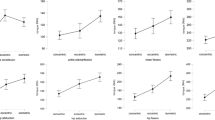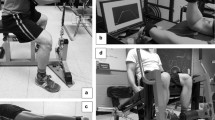Abstract
Isometric torque and isokinetic peak torque, total work, power, torque acceleration energy and acceleration time at 30, 120 and 240° · s−1 of the knee and elbow extensors and flexors were measured using an isokinetic dynamometer in 24 healthy women. Intra-session variation of the measurements was evaluated and the short-term and long-term reliability was assessed by repeating all procedures after averages of 2 and 30 days, respectively. The effect of learning on peak torque during a session was also evaluated. Moreover, the effect of general warming-up on knee extensor and flexor strength was examined on a separate day. Using correlations, numerous studies have indicated that muscle strength measurements are reliable. Correlations, however, are inappropriate and misleading in studies on reliability. In the present study reliability of each strength variable was expressed as the coefficient of variation (CV). With the protocol used, neither learning nor warming-up had any significant effect on strength. As expected, intra-session variation tended to be less than short-term and long-term inter-session variation. The CVs for strength variables measured 30 days apart exceeded 5% for all variables and rose to 107% for acceleration time. Substantial between-subject variation of individual CVs were found. The study demonstrated that muscle strength measurements may be highly unreliable in the individual subject.
Similar content being viewed by others
References
Altman DG (1991) Practical statistics for medical research. 1st edn. Chapman and Hall, London
Altman DG, Bland JM (1986) Statistical methods for assessing agreement between two methods of clinical measurements. Lancet I: 307–310
Bandy WD, Mclaughlin S (1993) Intramachine and intermachine reliability for selected dynamic muscle performance tests. J Orthop Sports Phys Ther 18: 609–613
Costong GMPJ, Janson PCW, Bas BW (1985) Short-term and long-term intea-individual variations and critical differences of haematological laboratory parameters. J Clin Chem Clin Biochem 23: 69–76
Friedlander AL, Block JE, Byl NN, Stubbs HA, Sadowsky JS, Genant HK (1991) Isokinetic limb and trunk muscle performance testing: short-term reliability. J Orthop Sports Phys Med 14: 220–224
Frontera WR, Hughes VA, Dallal GE, Evans WJ (1993) Reliability of isokinetic muscle strength testing in 45- to 78-old men and women. Arch Phys Med Rehabil 74: 1181–1185
Heinonen A, Sievänen H, Viitasalo J, Pasaneb M, Oja P, Vuori I (1994) Reproducibility of computer measurement of maximal isometric strength and electromyography in sedentary middleaged women. Eur J Appl Physiol 68: 310–314
Kannus P (1992) Normality, variability and predictability of work, power and torque acceleration energy with respect to peak torque in isokinetic muscle testing. Int J Sports Med 13: 249–256
Madsen OR, Brot C 1996 Assessment of extensor and flexor strength in the individual gonarthrotic patient. Interpretation of performance changes. Clin Rheumatol 15: 154–160
Magid E, Petersen PH, Christensen M (1992) A note on the theory of reference changes. Scand J Clin Lab Invest [Suppl] 208: 95–101
Matheson L, Mooney V, Caiozzo V, Jarvis G, Pottinger J, Deberry C, Backlund K, Klein K, Antoni J (1992) Effect of instructions on isokinetic trunk strength variability, reliability, absolute value, and predictive validity. Spine 17: 914–921
Mawdsley RH, Knapik JJ (1982) Comparison of isokinetic measurements with test repetitions. Phys Ther 62: 169–172
Morris-Chatta R, Buchner DM, de Lateur BJ Cress ME, Wagner EH (1994) Isokinetic testing in older adults: assessment of inter-rater reliability and stability of strength over six month. Arch Phys Med Rehabil 75: 1213–1216
Patterson LA, Spivey WE (1992) Validity and reliability of the Lido Active Isokinetic System. J Orthop Sports Phys Ther 15: 32–36
Sipilä S, Viitasalo J, Era P, Suominen H (1991) Muscle strength in male athletes aged 70–81 years and a population sample. Eur J Appl Physiol 63: 399–400
Suomi R, Surburg PR, Lecius P (1993) Reliability of isokinetic and isometric measurement of leg strength on men with mental retardation. Arch Phys Med Rehabil 74: 848–851
Vasikaran SD, McCloskey EV, Kahn S, Kanis JA (1994) Intraindividual variation in fasting urinary calcium- and hydroxyproline -creatinine ratios measured in metabolic bone clinic patients as both outpatients and inpatients. Ann Clin Biochem 31: 272–276
Wiktorsson-Möller M, Öberg B, Ekstrand J, Gillquist J (1983) Effects of warming-up, massage, and range of motion on muscle strength in the lower extremity. Am J Sports Med 11: 249–252
Author information
Authors and Affiliations
Rights and permissions
About this article
Cite this article
Madsen, O.R. Torque, total work, power, torque acceleration energy and acceleration time assessed on a dynamometer: reliability of knee and elbow extensor and flexor strength measurements. Europ. J. Appl. Physiol. 74, 206–210 (1996). https://doi.org/10.1007/BF00377442
Accepted:
Issue Date:
DOI: https://doi.org/10.1007/BF00377442




